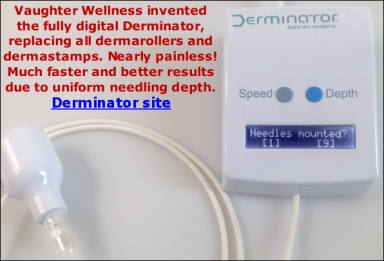Sorry to hear that your stretch marks did not improve. Are they red or white? How old?
Infadolan is not going to make any difference if dermarolling doesn’t work for your stretch marks. It is a regenerative ointment for optimal wound healing and it is very suitable for moisturizing and protection of the skin after dermarolling but it cannot anyhow remove deep cracks in the skin – which stretch marks are.
If you do not have too many stretch marks, you should buy the single needles and do an intensive needling of your stretch marks. You can for example needle every day just one stretch mark, but densely and thoroughly.
If you have too many stretch marks to use the single needles, buy our ONE LINER roller for intensive and targeted rolling of individual scars.
Immediately after needling or dermarolling, apply Tretinoin (the A-Ret gel, we sell it). Tretinoin which is an acidic form of vit. A was found to slightly improve early stretch marks and to a much lesser extent old stretch marks. Infadolan also contains vit. A but it contains the non acidic form in order to be gentle to the skin after dermarolling. If regular dermarolling did not help you, you have to try harsher treatments.
As you can read in the conclusion part of the first study, they do not know why Tretinoin improved stretch marks. If you apply it right after dermarolling, really a lot will be absorbed. Do not apply Tretinoin if pregnant, planning pregnancy or breastfeeding.
Topical Tretinoin (Retinoic Acid) Improves Early Stretch Marks
Sewon Kang, MD; Kwang J. Kim, MD, PhD; Christopher E. M. Griffiths, MD; Tai-Yuen Wong, MD; Harvinder S. Talwar, PhD; Gary J. Fisher, PhD; David Gordon, MD; Ted A. Hamilton, MS; Charles N. Ellis, MD; John J. Voorhees, MD
Arch Dermatol. 1996;132(5):519-526.
Abstract
Background and Design
Stretch marks are disfiguring lesions usually caused by excessive stretching of skin. We investigated the response of early, clinically active stretch marks to topical 0.1% tretinoin (retinoic acid) cream. In a double-blind, randomized, vehicle-controlled study, 22 patients applied either 0.1% tretinoin (n=10) or vehicle (n=12) daily for 6 months to the affected areas. Patients were evaluated by physical examination monthly and by analysis of biopsy specimens of stretch marks obtained before and at the end of therapy in comparison with untreated normal skin.
Results
After 2 months, patients treated with tretinoin had significant improvement in severity scores of stretch marks compared with patients who received vehicle (P<.05). After 6 months, eight (80%) of the 10 tretinointreated patients had definite or marked improvement compared with one (8%) of the 12 vehicle-treated patients (P=.002). Targeted stretch marks in patients treated with tretinoin had a decrease in mean length and width of 14% and 8%, respectively, compared with an increase of 10% (P<.001) and 24% (P=.008), respectively, in patients who received vehicle. There were no significant differences in various measures of quality and quantity of dermal collagen and elastic fibers in stretch marks when tretinoin and vehicle treatments were compared.
Conclusions
Topical application of tretinoin significantly improves the clinical appearance of early, active stretch marks. The processes that are responsible for the clinical improvement remain unknown.
Topical tretinoin 0.1% for pregnancy-related abdominal striae: An open-label, multicenter, prospective study
Onésimo Rangel, Isabel Arias, Edith García and Sergio Lopez-Padilla
Abstract
In an open-label, multicenter, prospective study, 20 women applied tretinoin (retinoic acid) cream 0.1% daily for 3 months to pregnancy-related stretch marks in the abdominal area. Efficacy was evaluated by analysis of one preselected target lesion, which was rated on a six-point scale (−1 = worse to 4 = cleared). At week 12, significant global improvement was noted from baseline in all stretch marks, and the target lesion decreased in length by 20% (P = .01). Erythema and scaling, the most common adverse events, occurred in 11 patients, decreased in severity after the first month of treatment, and were controlled with continued application of tretinoin and petroleum jelly ointment. In this small study, topical application of tretinoin significantly improved the clinical appearance of pregnancy-related stretch marks.






